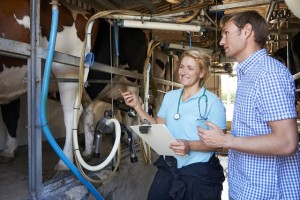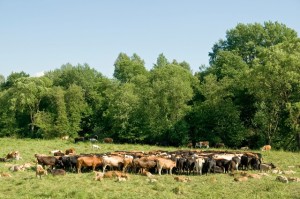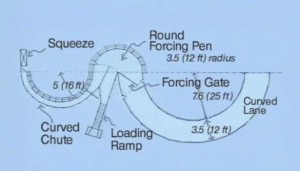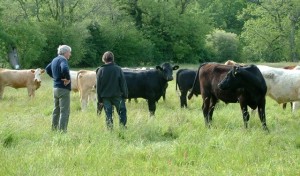Working With and Caring for Cattle
In this section we consider the key human requirements needed for those who are responsible for working with and caring for cattle, including the practices and skills required, but also the importance of human-animal interactions and knowledge of animal behaviour.
The Stockperson
The presence of a good stockperson is a basic requirement to ensure the health and welfare of livestock. Animals must be cared for by a sufficient number of staff having the appropriate ability, knowledge and professional competence. The general conclusions from research with different species, indicate that pleasant, consistent and confident handling leads to a good relationship. There is evidence that this relationship can be correlated with higher performance of animals (Seabrook, 1984; Hemsworth, 2003). Of course, positive interactions with animals can also have very positive impacts on human behaviour, and in particular, job satisfaction (Hemsworth and Coleman, 2011).
Health Planning

Both the animals and equipment should be regularly inspected for problems as part of the on-going health planning
Livestock farmers and stock-keepers should have a written health and welfare plan drawn up with the farm vet and, where necessary, other technical advisors. These plans should be reviewed and updated each year. A plan should set out health and husbandry activities that cover the whole year’s cycle of production, and include strategies to prevent, treat or limit existing disease problems. The plan should include records to enable monitoring and assessment of the health and welfare of the herd. Please visit the Health Planning page for more information on health planning.
Regular Inspection
There should be sufficient number of personnel with the required theoretical and practical knowledge of cattle and of the husbandry system to recognise whether the animals in their care appear to be in good health or not, including behavioural changes and whether the total environment is adequate to keep them healthy.
All animals should be thoroughly inspected at least once a day and a source of light should be available for this purpose when necessary. Tied animals should be closely inspected at least twice daily. These inspections should be carried out independently from any automatic surveillance equipment e.g. CCTV.
Where automated devices are used for measuring food intake, milk quality or body temperature, these should be used for monitoring health status and information checked at least twice daily.
At each inspection, special attention should be paid to body condition, movements and posture, rumination, condition of hair, skin, eyes, ears, tail, legs and feet. Healthy animals have sounds, activity, movements and posture appropriate to their age, sex, breed or physiological condition. These include: clear bright eyes, good posture, clean and shiny coat, sound feet and legs, normal feeding, ruminating, drinking, sucking or suckling behaviour, normal getting up, lying down, and resting behaviour and otherwise normal movements and behaviour. Attention should also be paid to the presence of external parasites, such as lice, to the condition of droppings and to feed and water consumption.
Thorough inspection of a herd does not necessarily mean that each animal has to be examined individually. Individual examination should be made on animals when overall inspection shows that this is necessary.
Separation from the group
Unusual behaviour
Loss of body condition
Loss of appetite
Sudden drop in milk yield
Diarrhoea (scouring)
Not chewing the cud
Discharge from nostrils or eyes
Producing excess saliva
Persistent coughing
Abnormal resting behaviour
Swollen joints
Lameness
Mastitis
Stock-Keeping Skills
Training and the acquisition of skills that enables stock persons and animal handlers to have improved attitudes and behaviours towards animals in their care, and to enable more appropriate handling, has been shown to significantly reduce stress (Grandin, 2010) and improve yield (Hemsworth et al., 2002).
A stock-keeper has the most significant influence on the welfare of cattle. Stock-keepers should be competent in a wide range of animal health and welfare skills, including:
ear tagging
disbudding
castrations
administering medicines
preventing and treating internal and external parasites
preventing and treating basic common causes of lameness
removing supernumerary (extra) teats
milking
Further, attitudes and behaviour to animals are as an important part of a stockperson’s skills and training requirements as are codes of practice, legislation and husbandry competence. A good stockperson requires good general knowledge of the nutritional, environmental, social and health requirements of animals and be able to promptly and effectively react to departures in behaviour, health and performance (Hemsworth and Coleman, 2011).
Handling Skills

Extensively managed cattle have less human contact when young, which can result in fear and sometimes aggression towards to humans when they are handled. The stress is increased during infrequent handling events, such as veterinary treatments. This can also result in mis-mothering, meat bruising and severe injury. Although not always practical, these problems can be reduced by brief and non- aversive handling during particular periods. For example, calves receiving 10 days of handling during the first three months of age or just after artificial weaning when 8 months of age are easier to handle than non-handled animals (Le Neindre et al., 1996).
Cattle should be moved at their own pace, without being hurried by stock-keepers, vehicles or dogs. They should be encouraged gently – especially around corners and where it is slippery underfoot. Excessive noise, excitement or force should be avoided. Putting undue physical pressure or striking particularly sensitive parts of the body, such as the head or udder, should be avoided. Sticks or other similar handling implements should only be used to guide animals, and these should not have a sharp or pointed end. The use of electric goads on cattle should be avoided as far as possible.
The handling of animals should foster a positive relationship between humans and animals and should be placed on pleasant, consistent and confident handling and not causing injury, panic, lasting fear or avoidable stress. There have been numerous studies showing the importance of positive human–animal relationship in reducing stress and ensuring high productivity (Waiblinger et al., 2006; Hemsworth et al., 2000; Hemsworth and Coleman, 2011). There is evidence that this relationship can be correlated with higher performance of animals. Using physical force and rapid and violent movements can negatively affect cow health and it has been shown that animals that the degree of patience shown by the farmer can have influence the incidence of lameness (Chesterton et al., 1989).
Handling in the first 2 days after birth may be very important in the development of the subsequent interactions between humans and cattle (Jago et al., 1998) and early gentle touching of beef cattle has been shown to have long-term persistent effects, reducing fear towards humans, as well as potentially increasing meat quality (Probst et al., 2012).
Handling Skills and Equipment
Knowledge of an animal’s natural response to stress is a key factor in the way we handle them and the way we design low stress handling facilities. Cattle handlers with an understanding of animal behaviour can handle livestock more efficiently and safely than handlers that lack an appreciation for the behaviour of animals and their welfare. Quiet, efficient handling will reduce stress and injuries to both people and livestock (Grandin, 1987). Likewise, this knowledge can be used to design low-stress handling facilities. Grandin (1980) promotes the use of circular handling facilities for cattle as:

Curved cattle handling facilities are ideal for animals that are not used to being handles. They work more efficiently and can be used on ranches, feed lots and at slaughter plants.
- When animal go around the curve, they think they are going back to where they came from
- Animals cannot see people and other moving objects at the end of the chute
- It takes advantage of the natural circling behaviour of cattle and sheep.
This type of design is ideal for animals that are not normally handled e.g. ranched animals. A typical design is shown here and more detailed information can be found at http://www.grandin.com/.
From the curved race, the animals can either be sorted into the diagonal pens, or directed to a squeeze chute, a dipping tank, or restraining facility. The handler works along the inner radius of the race which enables cattle to circle and view the handler. At the end of the curved holding race cattle enter a rounded holding area where they have 360° panoramic vision and poor depth perception. Single file races, forcing pens, and other areas where cattle are crowded should have high solid fences to keep animals calm by preventing them observing people and other distractions. Sharp contrasts of light and dark should be avoided as should shadows, sparkling reflections, high-pitch noise and moving objects (Grandin, 1980; 1990 and 1997).
Equipment for restraining cattle for veterinary procedures should utilize three behavioural principles: (i) blocking the animal’s vision; (ii) slow steady motion of parts of the apparatus which are pressed against the animal; and (iii) optimal pressure. While a restraint device should apply sufficient pressure to provide the feeling of being held, it should not exert excessive pressure that causes pain or struggling. will cause cattle to balk and impede movement through the race (Grandin, 1997).
Handlers should be aware of the animal’s personal space, known as the flight zone. The size of this zone is dependent on how frequently an animal is handled and whether it is agitated. Cattle tend to move in the opposite direction when a handler walks deep in their flight zone, and by crossing the point of balance it is possible to move an animal in the desired direction. Moving too far into the flight zone can result in an animal moving away from the desired direction. The video below demonstrates the concept.


 American English
American English


Comments are closed.